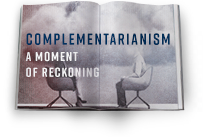Book Review: (A)Typical Woman: Free, Whole, and Called in Christ, by Abigail Dodds
Abigail Dodds, (A)Typical Woman: Free, Whole, and Called in Christ. Crossway, 2019. 160 pages.
Reviewed by Chesed Broggi
I rolled my eyes. Why did the three-pack of leggings purchased for my daughter have to have one pair with “Girl Power” splashed across them repeatedly? Whatever—I would just tuck them in the drawer next to her sister’s “Brave, Bold, Strong” t-shirt.
Shirts and leggings aren’t the only items emblazoned with “girl power.” As a woman with four daughters, I feel stalked by marketers selling this message. Honestly, it communicates the opposite of empowerment to me. It makes me feel like women are the last kid to finish the race, the kid for whom everyone feels obligated to cheer the loudest: “Good job, Susie—you did it!”
SUMMARY
I don’t know how Abigail Dodds feels about “empowerment” messages on clothing. But her new book, (A)typical Woman, is a substantive and real message of empowerment for women.
(A)typical Woman encourages Christian women to live confidently and fully as female followers of Christ in two primary ways. First, Dodds encourages her readers to reject a “narrow conception of womanhood.” She writes, “When we make the distinctive parts of womanhood the totality of it we confine ourselves unnecessarily to only our differences [and] we unnecessarily stunt our expression of womanhood” (37).
Second, Dodds encourages her readers to reject womanhood as understood or expressed individualistically apart from Christ and his church. She urges women to instead think of themselves as hidden in Christ and united with other believers “growing together, in Christ” (30). Her emphasis on womanhood lived out in the local church is biblical and avoids formulaic expression.
Dodds fleshes out this two-part message in three sections. In the first section, she lays the philosophical groundwork for Christian womanhood. The second section applies that groundwork to specific seasons of life. The concluding section explores truth for our lives through all seasons.
Throughout the book, Dodds stresses the comprehensive nature of womanhood. It’s not relegated to what’s uniquely female about women. It’s our whole being—mind, body, and soul—everything we do we do as women from hauling brush to baking bread. “Our attitudes and behaviors indicate who we bow down to, not what we are” (38). In the same way, all of God’s Word is addressed to women, not just the sections that specifically focus on biblical femininity. So there’s no reason not to be a student of all of Scripture.
This argument includes an important caveat that Dodds illustrates with one of her best analogies. If someone wrote a letter to your family but there was a part that mentioned you by name, you would pay special attention to that part of the letter. That’s how we should view passages that address women (45). Even while she points out that our distinctives don’t comprise the totality of our womanhood, she celebrates them. She’s clear that being a “helper, a wife, and a mom . . . teaching and training women . . . prioritizing the home” is good (39). As we live out this full Christian womanhood, different from the womanhood of the world, we have more, not less!
The next section of (A)typical Woman applies considers practical issues in the various contexts where Christian women find themselves. In singleness, marriage, motherhood, work, and discipleship, Dodds exhorts women to look to Christ for their fulfillment, guidance, and model of submission, all relying on one another in the body of Christ. Sticking to the “(A)typical” nature of her title, she addresses how childless women can and should mother, how unmarried women can instruct married women how to be wives. After all, we’re all students of the Word, right? For that matter, the unemployed help the employed think through how to work well and honor God in their career. A highlight of this section comes in a single question: “Am I faithfully obeying God as his child by meeting genuine needs of others, or am I pursuing self-actualization, self-fulfillment, or selfish ambition apart from him?” (99) Talk about an atypical question that turns the values of the world upside-down!
The third and final section of (A)typical Woman considers truths about the life of every Christian woman: weak and strong, free and finite but serving an infinite Savior. In the portion on freedom, the author points out a hypocritical irony. Women sometimes balk at submission to authority in the home and the church. But we love submitting to worldly authorities and living by strict, pharisaical rules when it comes to wearing uncomfortable clothes, cleaning our homes only with certain products, eating the strictest diets, keeping the most grueling exercise regimens, or adhering to weighty mothering “rulebooks.” None of these things are wrong per se, but it’s “wrong to do them because you trust the world (or yourself) more than Christ” (135). I continue to ask myself an important question after finishing this book: What am I submitting to and why?
CONCLUSION
(A)typical Woman is not a systematic treatment of biblical womanhood. Dodds doesn’t spend much time defending her particular positions with careful exegesis. Instead, she offers self-identified complementarian women a fresh look at how to follow Christ in light of their theology. That’s not a criticism. Instead, (A)typical Woman would be a great selection for a women’s group, especially because the author helpfully includes discussion questions at the end of each chapter.
This book flies in the face of our self-focused, “girls run the world,” pump-up culture. Dodds offers one thought-provoking take after another, and the overall mission of her book rings timely and true. The home, the church, and the world need mothers, sisters, daughters, aunts, and grandmothers to point them to Christ! What a privilege to be on that mission—not merely as a human, but as a woman. I think that’s why she wrote this book, and that’s a message worth splashing across some leggings.









